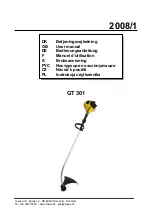
11
IE
GB
NI
• In case of horizontal cutting, move
the hedge trimmer in a sickle-shaped
movement to the edge of the hedge, so
that cut branches fall to the ground.
• In order to achieve long straight lines,
the placing of tensioned guiding cords
is recommended.
Cutting Shaped Hedges:
It is recommended that hedges be cut in
a trapezoidal shape, in order to prevent
stripping off of the lower branches. This
corresponds to the natural plant growth
and allows the hedge to thrive optimally.
During cutting, only the new annual
growths are reduced and thus a dense
branching and a good screen will develop.
1. Cut the sides of a hedge first.
To do this, move the hedge trim-
mer in the direction of growth
from bottom to top. If you cut
down from the top, the thinner
branches will move out, which
may result in some areas having
sparse growth or holes.
2. Cut the top edge, according to
taste, in a flat shape, roof shape
or rounded shape
3. Trim young plants to the required
shape. The main growth should
remain undamaged until the
hedge has reached the planned
height. All other shoots are
lopped off to half size.
Care of Free-Growing Hedges:
Free-growing hedges are not shaped
when cut, although they must be regularly
maintained so the hedge does not be-
come too high.
Maintenance/Cleaning
Repair and servicing work not
described in this manual should
always be carried by our Service
Centre. Use only original parts.
This will prevent damage to the
equipment and any resulting per-
sonal injury.
Pull out the power plug before car-
rying out any work on the equip-
ment. There is a risk of electrocution
or of injury from moving parts.
Wear gloves while handling the
blades. Risk of cuts.
Do not use any cleaning agents or
solvents. These could cause irrepa-
rable damage to the equipment.
Chemical substances can attack the
plastic parts of the equipment.
Carry out the following maintenance and
cleaning work regularly. This will guaran-
tee a long and reliable service life.
• Before each use, check the hedge trim-
mer for obvious defects such as loose,
worn or damaged parts. Check the
secure seating of the bolts in the cutter
bar (
2).
• Do not use the unit if the blades are
blunt or worn. This will overstress the
motor and gearbox of the machine.
• Check coverings and safety devices
(
1,3) for damage and correct seat-
ing. Replace these where necessary.
• Keep the ventilation slots (
5) and
motor housing of the device clean. Use
a damp cloth or a brush to do this. Do
not wash down the equipment with wa-
ter, or submerge it in water.
Содержание FHT 600 E3
Страница 3: ...1 2 2 3 4 5 6 8 9 10 4 6 ...
Страница 30: ...30 ...
Страница 32: ...32 ...
Страница 33: ...33 2017 05 24_rev02_sh Exploded Drawing Explosionszeichnung informative informativ FHT 600 E3 ...












































